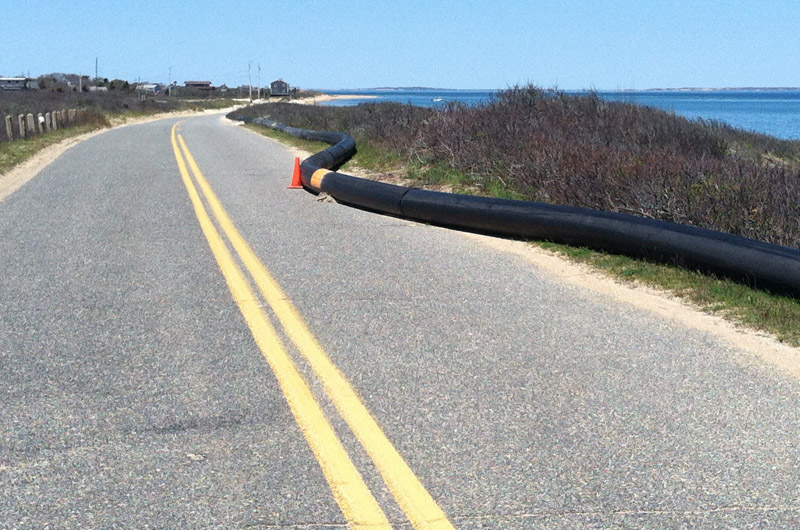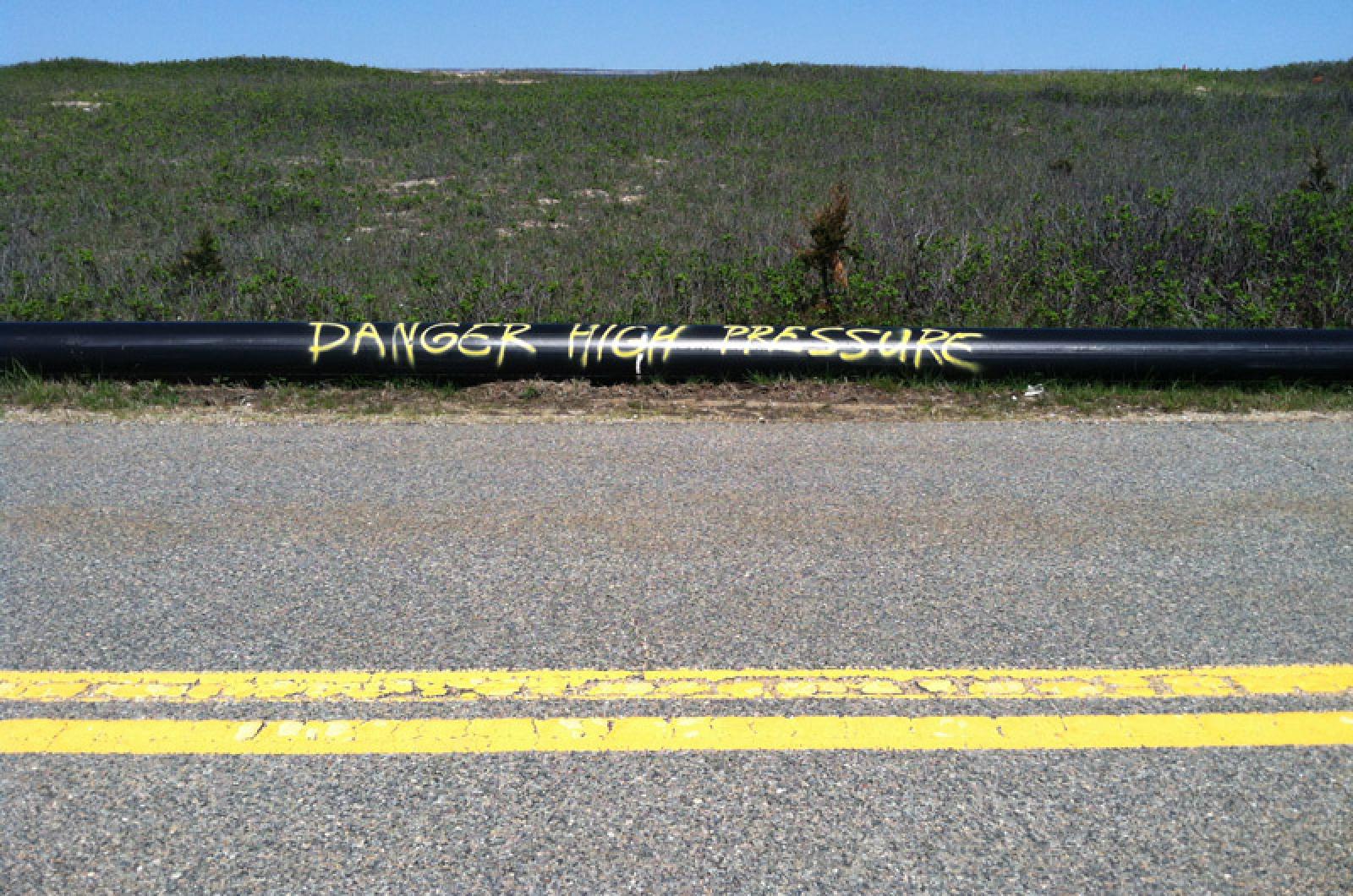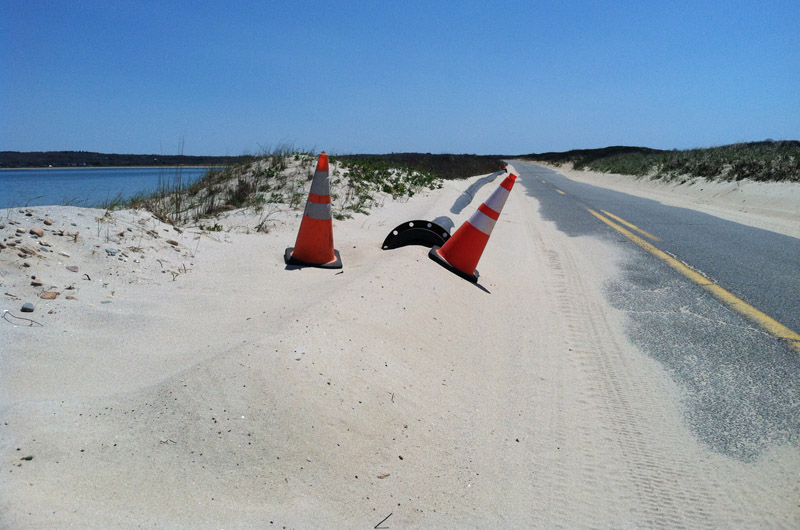An unfinished dredging project in Menemsha has come to a new impasse as town officials and the Army Corps of Engineers sort their options for dealing with equipment that the contractor has said would be too expensive to remove and set back up in the fall, when it hopes to resume dredging.
J-Way Inc, the Avon, Ohio, contractor, got a late start last winter and was halted by a Jan. 31 state deadline to allow for the migration of winter flounder. A right of entry between the Army Corps, the town of Aquinnah and the Wampanoag Tribe expired on April 15. But much of the equipment remains in place, including a mile and a half of piping in Aquinnah, raising concerns about public safety and potential threats to shellfish habitat in Menemsha Pond in the event of an equipment leak.
As of this week, the dredge still sat on its barge near the north end of the pond, where the warmer weather will soon bring an influx of recreational boats. A large pipeline snaked about a mile and half along Lobsterville and West Basin Roads, marked with orange cones where in spots where it jutted out onto the pavement.
“It’s only a matter of time before someone is going to have an accident,” town administrator Adam Wilson said of the pipeline, although he sees few options for moving it before summer. “I don’t think we are in a position to do it ourselves, either legally or financially,” he said.
About 16,000 cubic yards of sand has been pumped onto Lobsterville Beach, which was badly damaged during Hurricane Sandy in 2012. About 45,000 cubic yards are left to be cleared from the channel. J-Way owner Allen Johnson told the Gazette this week that removing the remaining equipment would be a major undertaking.
“We are awaiting some decisions from various agencies, including the Corps and the state,” he said. “The problem is that there has been a huge amount of money spent to place the equipment, and to remove it and start over again would be a huge undertaking as far as expense.” He blamed the delay mostly on the mandatory Jan. 31 deadline, arguing that winter flounder have long been absent in the pond.
Fishermen and biologists in Chilmark and Aquinnah say otherwise.
Aquinnah fisherman and charter captain Buddy Vanderhoop, who scallops on the pond in winter, claimed seeing “tons of them” this winter. He speculated that winter flounder were also present in Nashaquitsa Pond to the south. “As a rule, they come back in January to spawn and then they go back out into the Sound, probably around the end of April, after dumping all their eggs,” Mr. Vanderhoop said.
Four years ago the Wampanoag shellfish hatchery released 5,000 winter flounder into Menemsha Pond, in partnership with the University of New Hampshire and the former Martha’s Vineyard/Dukes County Fisherman’s Association, with funding from NOAA. “They always come back to where they were born,” Mr. Vanderhoop said.

Bret Stearns, director of natural resource protection for the tribe, also confirmed that winter flounder were present in Menemsha Pond this winter.
“The rules are there for a reason,” he said. “We are trying to protect species that are important to the history and to the future of the Island.”
A smaller dredging and beach renourishment project at Eel Pond and Fuller street beach in Edgartown was completed on time last year before the start of the winter flounder season. Edgartown operates its own dredge program.
The Menemsha channel dredging was supposed to begin last fall but was delayed when road closures from a hurricane in South Carolina slowed the movement of the dredge north from Georgia. The project finally got going in late December, making it nearly impossible to finish by the Jan. 31 deadline. Mr. Johnson said he could have completed the work with a six-week extension. J-Way’s estimate for mobilization and demobilization made up about half the cost of its $2.17 million bid for the project, according to a record of bids available online. The company has removed its booster pump from near the West Basin, along with a bulldozer from Lobsterville Beach, but Mr. Johnson said removing the rest would cost six figures. “That’s kind of where we’re having a little bit of an impasse,” he said.
The Army Corps itself appears to have run out of options and is considering terminating its contract with J-Way. Project manager Craig Martin said Tuesday that the decision would be made soon. “It’s imminent,” he said.
“We have directed the contractor to remove the equipment, specifically from the water in the federal channel,” Mr. Martin said. But most of the equipment on land is within rights of access negotiated between J-Way, the town and the tribe. “They were trying to make it easier for the contractor to get the material to the beach,” Mr. Martin said, adding that Aquinnah “absolutely” has the authority to make J-Way remove the pipeline. “Unfortunately it’s outside the rights of entry for the Corps,” he said.
The Corps has complained of a lack of responsiveness from J-Way. In addition to the delays, the company caused some damage to the West Basin parking lot and displaced a pile marking the town boundary. “There were a number of things that we required J-Way to complete as a part of the project,” Mr. Martin said, noting the various damages. “We do not believe most of what we have requested has been completed,” he said.
Meanwhile, Chilmark, which shares the pond and channel with Aquinnah, is working with the state to size up its own authority. Last week the town selectmen discussed placing lighted buoys in the pond to mark the equipment, which is now considered a navigational hazard. Chilmark harbor master Dennis Jason has prepared a presentation that the Coast Guard has passed up its chain of command.
The selectmen had opposed the project from the beginning. But since the channel and pond are part of a federal navigation project and the area is considered a harbor of refuge, the dredging did not require town approval and the Army Corps went ahead despite the town’s objections.
Mr. Johnson acknowledged having ruffled some feathers. He also said permitting delays associated with state deadlines are part of the business.
J-Way has worked in the region before, but this is its first job for the Army Corps and its first on the Vineyard. The Gazette learned this winter that of the five companies that bid on the contract, J-Way was the only one without an Army Corps record. The company’s bid came in about $800,000 under the highest bidder, due mostly to a lower budget for mobilization and demobilization.
After dredging in the pond was halted in January, work continued at Lobsterville Beach, where the new sand was shaped. A few weeks ago a large group of volunteers planted about 19,000 stalks of beach grass to stabilize the area.
Mr. Stearns said he hope the project can resume in the fall, with or without J-Way as the contractor.
Mr. Martin said he believes the remaining 45,000 cubic yards of sand could be moved in a single season. But dredging now will likely have to wait until after the Martha’s Vineyard Striped Bass and Bluefish Derby, which ends Oct. 15.







Comments
Comment policy »